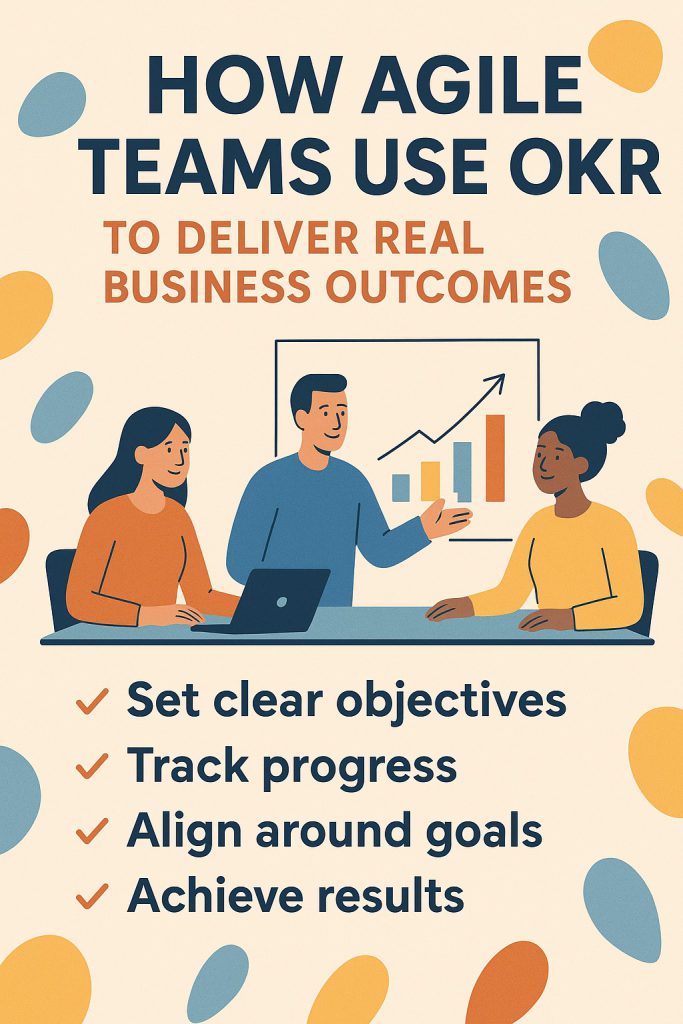In today’s fast-moving business landscape, simply completing tasks or releasing new features is no longer enough. Customers don’t measure success by the number of sprints completed or how many user stories were delivered — they measure it by the real value they receive. That’s why many Agile teams are now turning to OKRs (Objectives and Key Results) to connect their day-to-day work with tangible business outcomes.
But here is the challenge: Agile and Scrum already have their own structures — sprint goals, product backlogs, retrospectives. How do OKRs fit in? And how do you make sure they actually drive impact rather than becoming another reporting layer? Let’s break it down.
Why Agile Teams Need OKRs
Agile frameworks like Scrum emphasize delivering increments of value in short cycles. However, without a bigger picture, teams often risk falling into the “feature factory” trap — churning out tasks without understanding their purpose. This is where OKRs bridge the gap:
Objectives give teams a clear “north star” — the why behind the work.
Key Results define how success will be measured in terms of outcomes, not outputs.
For example, an Agile team may have an objective like: “Improve customer onboarding experience.” Instead of measuring success by “number of new features built,” the key results could be:
Reduce average onboarding time from 10 days to 3 days.
Increase customer activation rate from 60% to 80%.
Achieve a customer satisfaction score of 8/10 in onboarding feedback surveys.
Notice that the focus shifts from “what we did” to “what difference it made.”
OKRs vs. Traditional Agile Metrics
Most Agile teams are used to metrics like velocity, burndown charts, and story points. While these are useful for tracking activity, they don’t reflect customer or business value. OKRs push teams to go beyond outputs to measure real outcomes.
Velocity tells you how fast a team is delivering.
OKRs tell you if the delivery is making an impact.
Think of it this way: It’s not about how many features you build, it’s about whether those features improve retention, revenue, or customer happiness.
How to Align OKRs with Agile Ceremonies
One of the most common questions Agile teams ask is: “How do OKRs actually fit into Scrum ceremonies?” Here’s how:
Sprint Planning & Backlog Refinement
Align backlog items with OKRs. Instead of just prioritizing features, ask: “Which backlog items directly move us closer to our Key Results?”
Daily Standups
Instead of only discussing “what I did yesterday” and “what I’ll do today,” tie progress updates back to OKRs. For example: “Yesterday I worked on the onboarding tutorial, which supports our objective of reducing churn.”
Sprint Reviews
Go beyond demoing features. Use sprint reviews to show data: “This feature reduced onboarding time by 20%, moving us toward our KR.”
Retrospectives
Reflect on whether the sprint work actually impacted outcomes. If not, what can be adjusted in the next sprint?
Common Pitfalls to Avoid
While OKRs can be powerful, Agile teams often run into challenges:
Confusing Outputs with Outcomes
Writing key results like “deliver five new features” misses the point. A better KR is “increase weekly active users by 15%.”
Setting Too Many OKRs
Teams overwhelmed with 10+ OKRs lose focus. Best practice: stick to 1–3 objectives per quarter.
Treating OKRs as Top-Down Mandates
OKRs work best when created collaboratively, not handed down. Agile teams should co-create them with product owners and stakeholders.
The Business Impact of OKRs in Agile
When Agile teams effectively integrate OKRs, the results are tangible:
Clearer alignment with strategy – Every sprint connects to business priorities.
Faster learning cycles – Teams validate impact quickly and adjust.
Higher stakeholder trust – Leaders see value beyond “story points.”
Motivated teams – Developers and analysts understand why their work matters.
OKRs ensure that Agile is not just about speed, but about delivering meaningful outcomes.
Final Thoughts
Agile frameworks like Scrum give teams the rhythm and discipline to deliver iteratively. OKRs provide the compass to ensure they’re moving in the right direction. Together, they create a powerful engine for business success — where every sprint drives measurable impact, not just activity.
The future of Agile isn’t about working faster. It’s about working smarter — focusing on outcomes that matter.
👉 Take your Agile and leadership journey to the next level with ScrumConsult.
Whether you’re pursuing Scrum Master Certification, Product Owner, Project Management, Lean Six Sigma, or Agile Expert programs, we’ll equip you with the skills to align your work with real business outcomes.

